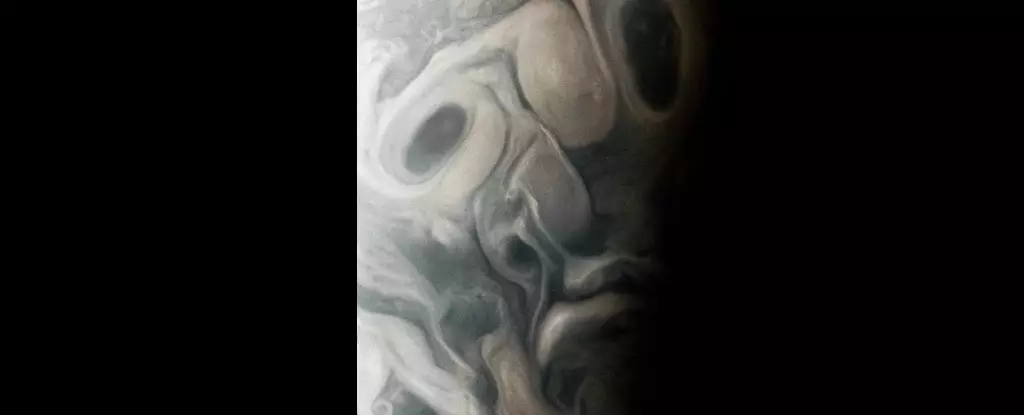

Jupiter, the largest planet in our Solar System, continues to fascinate scientists and astrophotographers alike. Its colossal size and tempestuous storms make it an enigmatic celestial body worth studying. But what adds to its allure are the mesmerizing cloud formations that dance and swirl across its atmosphere. These cloud formations can take on eerie and uncanny shapes, evoking emotions in the beholder. Recently, NASA’s Juno probe captured a captivating cloud formation that bears a striking resemblance to a face filled with angst and dread. This article delves into this peculiar formation and the secrets it unveils about Jupiter’s atmosphere.
On September 7, 2023, during its 54th close flyby, or perijove, NASA’s Juno probe captured an intriguing region in the far north of Jupiter known as Jet N7. Jets on Jupiter are the wind streams that separate the planet’s distinct belts and zones. These jets penetrate deep into the Jovian atmosphere, giving rise to complex and captivating cloud patterns. Juno’s close proximity to Jupiter, only 7,700 kilometers (4,800 miles) above its cloud tops, provided an unprecedented opportunity to observe the terminator over Jet N7. The terminator is the boundary between night and day, and its elongating shadows allow scientists to study the intricate features of Jupiter’s cloud tops, akin to illuminating texture in an oil painting.
Juno’s mission to study Jupiter has been instrumental in unraveling the mysteries of this gas giant. Since its first perijove in July 2016, Juno has made regular close approaches to Jupiter, capturing breathtaking images of its spectacular clouds. These ongoing observations help scientists understand the dynamics of Jupiter’s turbulent storms, adding vital pieces to the puzzle of Jupiter’s atmospheric processes. Nonetheless, there is still much we don’t know about this colossal planet, and the technology we deploy to investigate it continues to uncover its hidden secrets.
As humans, we possess a cognitive bias known as pareidolia, which causes us to interpret random stimuli as familiar patterns, such as faces or animals. This psychological phenomenon often leads us to spot recognizable features within the clouds of Jupiter. However, one of the most powerful forms of pareidolia is face pareidolia, where we perceive human-like facial expressions, age, and even gender in abstract shapes. It is not surprising, then, that we can find a face within the cloud formations of Jupiter, as captured by Juno’s imagery. What is surprising, perhaps, is that such occurrences are not more frequent. Perhaps a closer examination is needed to uncover even more captivating formations lurking within Jupiter’s clouds.
The recent capture of a face-like cloud formation on Jupiter serves as a reminder of the wonders that lie within our cosmic neighborhood. This extraordinary finding not only captivates the imagination but also contributes to our scientific understanding of Jupiter’s atmospheric dynamics. By studying the intricate details of these cloud formations, scientists can gain insights into the complex weather systems and storms that define Jupiter’s atmosphere. Each new glimpse of Jupiter’s clouds allows us to deepen our knowledge and appreciation for the awe-inspiring beauty of this gas giant.
The cloud formations on Jupiter continue to astound and unsettle us with their intricate patterns and familiar shapes. NASA’s Juno probe has played a pivotal role in capturing and decoding these enigmatic formations, providing valuable insights into the mysteries of Jupiter’s atmosphere. As we venture further into the study of our solar system, it is vital to embrace the uncharted and explore the vast wonders that await us. So, let us continue to gaze upwards, marveling at the celestial ballet performed by Jupiter’s ever-changing cloud formations.
The northernmost regions of the world are undergoing profound transformations due to climate change, particularly…
Light serves as a fundamental medium for transmitting information across various domains, stretching from traditional…
Recent advancements in 3D printing at the University of California San Diego offer a promising…
South Africa's Northern Cape province has emerged as a beacon of investment in renewable energy,…
Alzheimer's disease has long posed a global health challenge, affecting millions while complicating the lives…
The Moon, Earth's steadfast companion, has long intrigued humanity with its enigmatic past. While significant…
This website uses cookies.